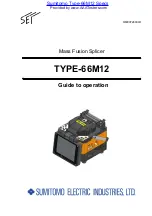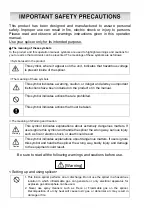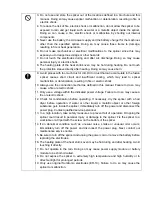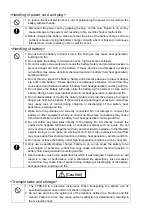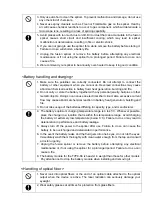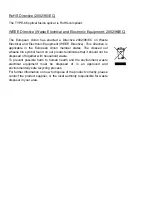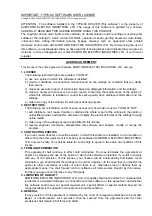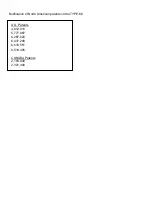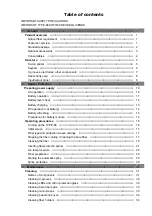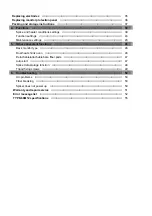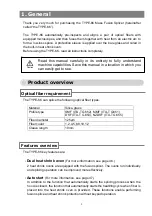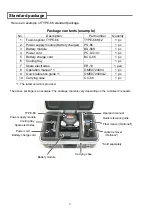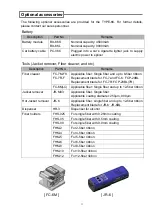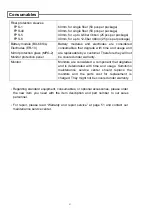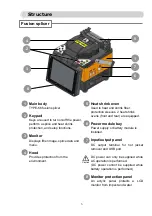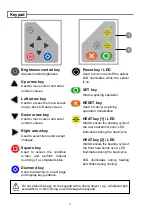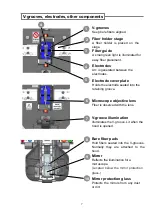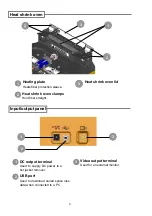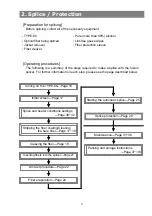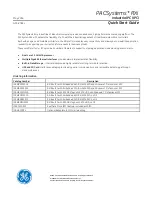
1. Do not burn the battery or throw it into a fire. Doing so may cause heat generation,
bursting and fire.
2. Do not place the battery in microwave ovens, high-pressure containers.
3. Do not let water or sea water wet or soak the battery. Safety and protective devices to
prevent danger are built in the battery. If these devices are damaged, excessive
current flow may cause abnormal chemical reaction in battery fluid, heat generation,
bursting and fire.
4. Do not throw or impact the battery. Safety and protective devices to prevent danger
are built in the battery. If these devices are damaged, excessive current flow may
cause abnormal chemical reaction in battery fluid, heat generation, bursting and fire.
5. Do not pierce the battery with nails, strike the battery with a hammer, or step on the
battery. Doing so will cause internal short circuit, heat generation, bursting and fire.
6. Do not disassemble or modify the battery. Safety and protective devices to prevent
danger are built in the battery. If these devices are damaged, excessive current flow
may cause loss of control during charging or discharging of the battery, heat
generation, bursting and fire.
7. Make sure the polarities are correctly connected. Do not attempt to connect the
battery or other equipment when you cannot do. Reversed connections may cause
abnormal chemical reaction in battery fluid, heat generation, bursting and fire.
8. Do not solder any lead wires directly to the battery. Do not directly connect the
positive and negative terminals with a conductive material such as a wire.
Do not
carry or store the battery together with any personal jewelry, hairpins or other Metallic
objects. Doing so can cause an electrical short circuit. Also excessive current flow
may cause abnormal chemical reaction in battery, heat generation, bursting and fire.
9. Do not use or leave the battery under high temperature conditions such as near fire.
10. Only use a specified battery charger. Failure to do so can cause the battery to be
overcharged or excessive current flow may cause abnormal chemical reaction in
battery fluid, heat generation, bursting and fire.
11. Use the battery only for the application for which it was designed. Failure to do so will
result in a loss of performance and a shortened life expectancy. Also excessive
current flow may cause loss of control during charging or discharging of the battery,
heat generation, bursting and fire.
<Handling of battery>
<Handling of power cord and plug >
1. To reduce the risk of electric shock, do not plug/unplug the power cord or remove the
battery with wet hands.
2. Disconnect the power cord by grasping the plug, not the cord. Failure to do so may
cause damage to the power cord, resulting in fire, electric shock or malfunction.
3. Before charging the battery, make sure that the pins of the battery charge cord are
not bent or broken. Using the battery charge cord with a bent or broken pin will cause
internal short circuit, resulting in fire or electric shock.
[Caution]
<Transportation and storage>
1. The TYPE-66 is a precision instrument. When transporting the splicer, use its
specified transport case and do not shock or impact it.
2. Do not use and store the splicer out of the locations defined in a brochure and this
manual. Failure to do so may cause splicer malfunction or deterioration, resulting in
fire or electric shock.
Summary of Contents for TYPE-66M12
Page 67: ...57...

